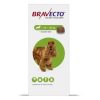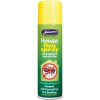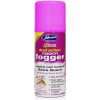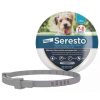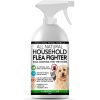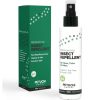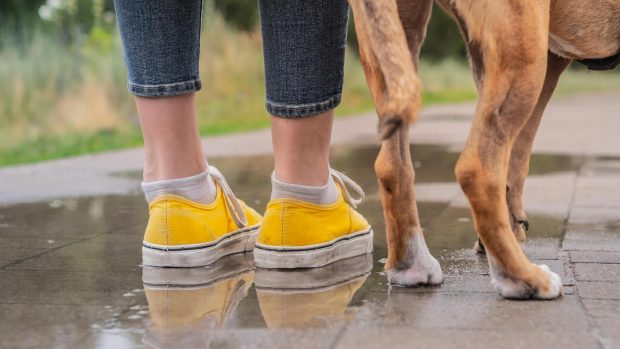You spot your dog scratching and hope against hope that it’s simply a mosquito bite. But the scratching persists. You do a cursory check for the dreaded fleas, and breathe a sigh of relief. But still the scratching goes on. Fleas are tiny and dark, and a dog’s thick fur can make them very difficult to spot, as well as the unsavoury fact that they move quickly. You can often miss them if you don’t search really thoroughly and by this time they have laid hundreds of eggs. So, you take a flea comb, comb through and rinse any residue under water over white kitchen towel – if it turns reddish brown, that means it’s flea dirt (poo) and you have an infestation. As fast as you can, because fleas multiply rapidly, you need to find the best ways to get rid of fleas – and use all of them.
From personal experience, don’t fall for the softly-softly approach. Fleas don’t just drown and wash away with a thorough bath and comb, and a spritz of citronella. A flea’s life cycle is such that even if you get rid of most of the adult fleas using this method, their eggs will hatch a few days later and you’ll be back to where you started. Nor can you treat just the dog you think is affected. Fleas can jump a long way. Every pet in the household is likely to have fleas.
Don’t stop with the animals. For every flea on the dog, there are probably another 100 eggs in nooks and crannies in the home. An adult female flea can lay 50 eggs a day. You need not only to thoroughly vacuum and disinfect any rooms in the house where the dogs hang out, but the same applies to their bedding and any other soft furnishings. A flea infestation needs a belt-and-braces approach.
The best ways to get rid of fleas in 6 steps
1. Apply a flea treatment
Some people say they can eliminate fleas by bathing, but for most dog owners, a specialised flea treatment is the best option. Most treatments will both eliminate existing infestations and continue to protect the dog for 12 weeks. Consult your vet for the best option for your dog. Bravecto is available in both chewable tablets or topical solution from Viovet.
Another popular product is Frontline Spot On (also available from Viovet). There is some evidence that fleas exposed to a certain chemical can become resistant to that drug, and therefore you may need to swap around from time to time. Bear in mind that some dog flea treatments contain the insecticide permethrin, which is safe for dogs but toxic to some other pets, such as cats.
Flea treatments typically clear flea burdens within 12–48 hours, faster if you administer a tablet, making it one of the best ways to get rid of fleas.
2. Clean all the bedding
Once the dog is treated, you need to eliminate the infestation from your home. Start with your dog’s bedding. Most dog beds are washable. Wash on the highest setting with detergent, and tumble dry if you can – this should kill all eggs and larvae as well as fleas. You should keep washing your dog’s bedding regularly – once a week is ideal.
3. Vacuum everywhere
Thoroughly vacuum everywhere the dog spends time, getting into all the nooks and crannies, corners, soft furnishings and so on. You must empty the vacuum cleaner and dispose of the bag immediately afterwards to prevent the eggs hatching and re-infesting your home.
4. Spray the home
If the infestation has been severe, you may want to treat soft furnishings with an insecticide such as Johnson’s Veterinary Household Flea Spray (available on Amazon). Johnsons also does a room defogger, which is a complete room treatment (also found on Amazon). However, these chemicals can be toxic, so follow the instructions carefully, keeping animals away while the area is treated. Look for sprays that are approved by vets.
5. Prevent future infestations
Now your home and dog are flea-free, you want to keep it that way. Ask your vet to recommend one of the best flea treatments for dogs, which will often guard against other nasties, such as sarcoptic mange and ticks as well. You want one that kills fleas at all life stages. Year-round flea and tick treatment is the only way to prevent future infestations. Some are sold over the counter while others require a prescription, and your vet will advise the best option for your particular dog.
You may also want your dog to wear a flea collar, such as Seresto’s flea & tick collar (available from Viovet).
A natural flea-fighting spray for the home is also a good idea to prevent any infestation occurring. The All Natural Household Flea Fighter, which you can buy on Amazon, is natural and non-toxic and can be used every week during the flea season. It smells nice too, with a coconut and lemongrass scent!
6. Groom regularly
This belt-and-braces approach should have you covered. But you’ll still want to keep an eye out for any unwanted visitors. Groom your dog regularly with a flea comb – you can get electric ones, but we like the manual Masterclip Flea Comb (found on Amazon) – and bathe him with one of the best dog shampoos for fleas, such as Johnson’s Vet Dog Flea Cleansing Shampoo (also found on Amazon). You can also spray a natural insect repellent on, such as Petuchi Organic Insect Repellent (available on Amazon).

Johnson’s Flea Shampoo at amazon.co.uk
This mild and non-irritant shampoo helps to cleanse fleas from the coat and is suitable for all breeds.
You may also enjoy reading…

Buzz off: the best flea treatments for dogs

Sleek and shiny: best dog conditioners to detangle coats and soothe itchy skin

Don’t scratch that itch! Best products to relieve your dog’s irritated skin

Best dog grooming brushes for luscious locks and shiny coats

Subscribe to Horse & Hound magazine today – and enjoy unlimited website access all year round
Horse & Hound magazine, out every Thursday, is packed with all the latest news and reports, as well as interviews, specials, nostalgia, vet and training advice. Find how you can enjoy the magazine delivered to your door every week, plus options to upgrade your subscription to access our online service that brings you breaking news and reports as well as other benefits.


